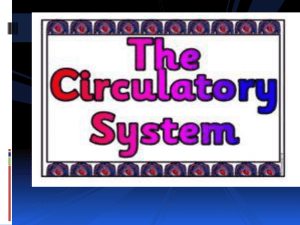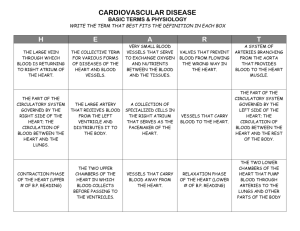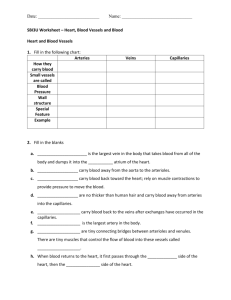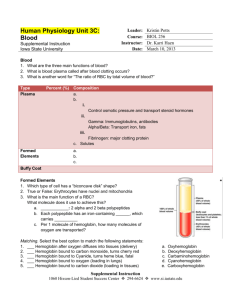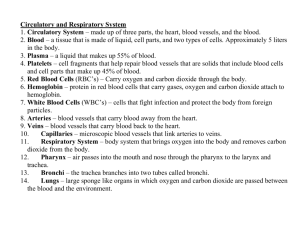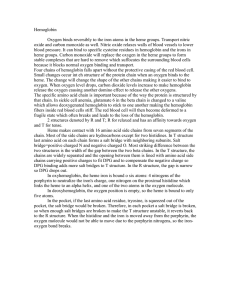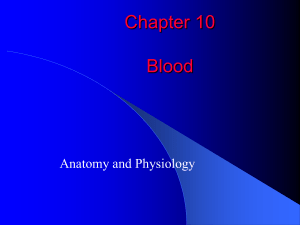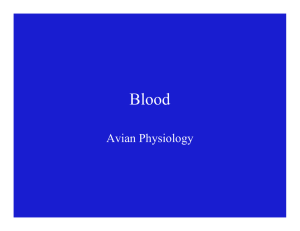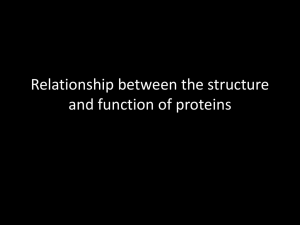THE CIRCULATORY SYSTEM
advertisement
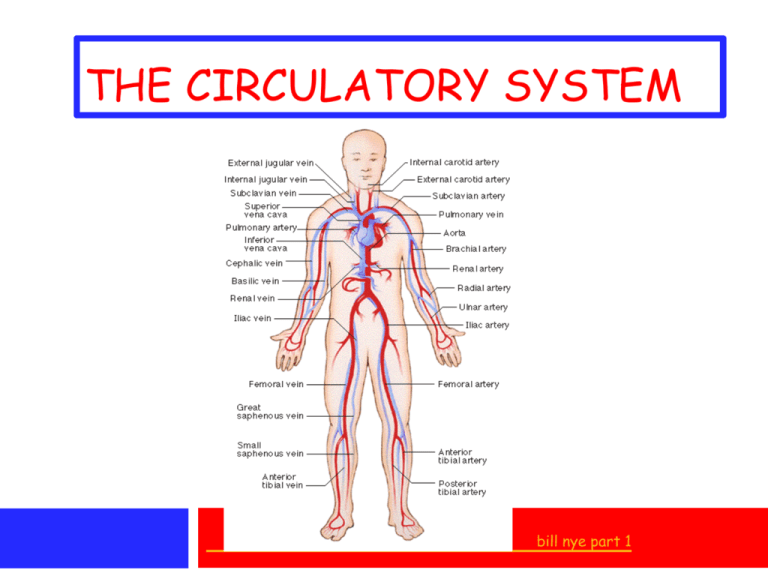
THE CIRCULATORY SYSTEM bill nye part 1 I. TRANSPORTATION SYSTEM * delivers OXYGEN to cells (RBC’S) * removes CARBON DIOXIDE * transports NUTRIENTS to body cells * defense (WBC’S & PLATELETS) * transports chemicals (ex. HORMONES) II. BLOOD VESSELS A. ARTERIES * AWAY from the heart * carry oxygenated blood (LOTS of OXYGEN) B. VEINS * TOWARD the heart * deoxygenated blood (LOTS of CO2) * have VALVES - prevent blood from flowing back C. CAPILLARIES * CONNECT arteries to veins * TINY (one RBC through at a time) III. HEART * 4 hollow chambers separated by the SEPTUM A. ATRIA (ATRIUM) - collecting chambers B. VENTRICLES - pumping chambers * PACEMAKER controls heartbeat; electrical signals IV. THE JOURNEY - starts on the right side A. RIGHTATRIUM * blood OXYGEN poor (deoxygenated) * lots of CARBON DIOXIDE * returning from BODY * blood passes through VALVE to: B. RIGHT VENTRICLE * pumps blood to LUNGS * CO2 exhaled & O2 picked up * blood returns to the: C. LEFT ATRIUM * lots of OXYGEN * blood passes through VALVE to: D. LEFT VENTRICLE * pumps blood to entire body through the AORTA - largest ARTERY * 6X stronger than right ventricle The Question: What color is your blood? The Answer: Red The Explanation: Each erythrocyte (red blood cell) contains approximately 280 million hemoglobin molecules which give blood its red color Each hemoglobin molecule consists of a protein, called globin, and an iron-containing pigment, called heme. Oxygen binds to the heme (pigment) part of the molecule making it red. If all the oxygen was removed, the heme would be blue. Arterial blood has a high oxygen content, having just picked up a fresh supply from the lungs, making it a bright cherry red color. Assume that all of the hemoglobin molecules are 100% oxygenated when they leave the lungs and the blood is a bright red color as it travels through the arteries. Blood is returned to the heart, and then to the lungs, by the veins. Venous blood is a deep, dark red color. This is due to that fact that it has released a lot of oxygen molecules (60%), but not all of the oxygen. Some of the heme pigment is blue, which will darken the red color of the blood, but it is still red. Consider a bruise. When capillaries are ruptured, the blood seeps into the tissues and the erythrocytes break. At first the blood in the area is red in color, but the tissues quickly use up the oxygen. The oxygen is not resupplied because the blood vessels have been broken. The injured area is now becoming blue due to the lack of oxygen. As the erythrocytes are broken down and reabsorbed (usually about 14 days), you can observe a change in color in the bruise. These color changes are the products of the breakdown of hemoglobin (from red to blue to green to yellow). V. BLOOD * CONNECTIVE tissue * 5 liters A. PLASMA - LIQUID portion - 55% of blood (90% of this WATER) - contains NUTRIENTS, ENZYMES, HORMONES, WASTES B. RED BLOOD CELLS - ERYTHROCYTES - 25 TRILLION - transport O2 & CO2 - contain HEMOGLOBIN (iron containing protein) C. WHITE BLOOD CELLS - LEUKOCYTES - fight DISEASE; defense system - 700 RBC : 1 WBC D. PLATELETS - CELL FRAGMENTS - aid in blood CLOTTING * FIBRIN: - helps blood clot; mesh trap VI. BLOOD GROUPS ** In 1900, Karl Landsteiner classified blood into 4 groups: * type of blood determined by presence or absence of ANTIGENS ON RBC’S TYPE CAN RECEIVE FROM CAN DONATE TO * O = UNIVERSAL DONOR * AB = UNIVERSAL RECIPIENT If any of 18 proteins in blood: POSITIVE No Rh proteins in blood: NEGATIVE * AGGLUTINATION- if given the wrong blood type, RBC’S clump (can’t transport O2) VII. CARDIOVASCULAR DISEASE * affect the heart and BLOOD VESSELS A. A. ATHEROSCLEROSIS * ARTERIES narrowed * caused by CHOLESTEROL (fatty) deposits ** ARTERIOSCLEROSIS - hardening of the arteries B. HYPERTENSION * HIGH BLOOD PRESSURE ~ BLOOD PRESSURE produced by the force of blood & the resistance of the blood vessel walls ~ b.p. rises each time the CONTRACTS to pump blood through blood vessels and falls each time the RELAXES between beats C. MYOCARDIAL INFARCTION * HEART ATTACK * blood flow to heart stopped open heart surgery E.STROKE D. ANEMIA * blood transports too little OXYGEN * low IRON DO THIS… OUT OF YOUR TEXTBOOK (DRAGONFLY): * READ 943-946 - DEFINE VOCAB WORDS (12) - ANSWER QUESTION 4 * READ PAGES 951-955 - DEFINE VOCAB WORDS (5) - ANSWER QUESTIONS 3&4 OUT OF THE OTHER TEXTBOOK (WOLF) * DRAW, COLOR (RED & BLUE), AND LABEL THE PICTURE OF THE HEART THAT’S ON PAGE 756

